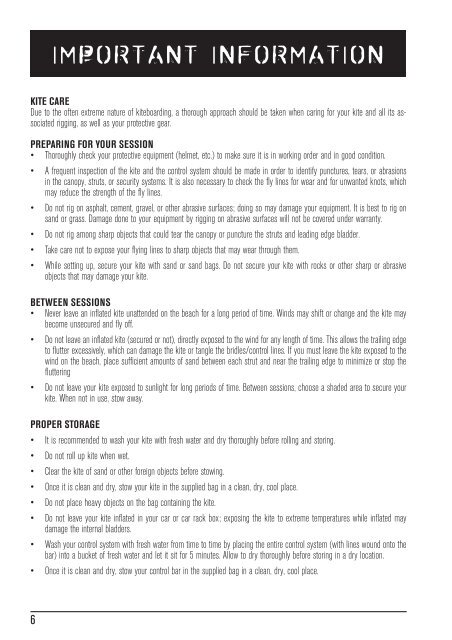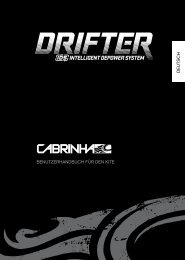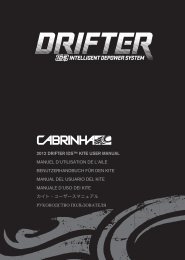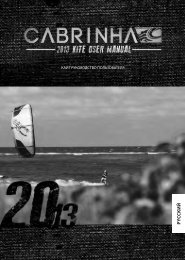SWITCHBLADE 2 - Cabrinha
SWITCHBLADE 2 - Cabrinha
SWITCHBLADE 2 - Cabrinha
Create successful ePaper yourself
Turn your PDF publications into a flip-book with our unique Google optimized e-Paper software.
IMPORTANT INFORMATION<br />
KITE CARE<br />
Due to the often extreme nature of kiteboarding, a thorough approach should be taken when caring for your kite and all its associated<br />
rigging, as well as your protective gear.<br />
PREPARING FOR YOUR SESSION<br />
• Thoroughly check your protective equipment (helmet, etc.) to make sure it is in working order and in good condition.<br />
• A frequent inspection of the kite and the control system should be made in order to identify punctures, tears, or abrasions<br />
in the canopy, struts, or security systems. It is also necessary to check the fly lines for wear and for unwanted knots, which<br />
may reduce the strength of the fly lines.<br />
• Do not rig on asphalt, cement, gravel, or other abrasive surfaces; doing so may damage your equipment. It is best to rig on<br />
sand or grass. Damage done to your equipment by rigging on abrasive surfaces will not be covered under warranty.<br />
• Do not rig among sharp objects that could tear the canopy or puncture the struts and leading edge bladder.<br />
• Take care not to expose your flying lines to sharp objects that may wear through them.<br />
• While setting up, secure your kite with sand or sand bags. Do not secure your kite with rocks or other sharp or abrasive<br />
objects that may damage your kite.<br />
BETWEEN SESSIONS<br />
• Never leave an inflated kite unattended on the beach for a long period of time. Winds may shift or change and the kite may<br />
become unsecured and fly off.<br />
• Do not leave an inflated kite (secured or not), directly exposed to the wind for any length of time. This allows the trailing edge<br />
to flutter excessively, which can damage the kite or tangle the bridles/control lines. If you must leave the kite exposed to the<br />
wind on the beach, place sufficient amounts of sand between each strut and near the trailing edge to minimize or stop the<br />
fluttering<br />
• Do not leave your kite exposed to sunlight for long periods of time. Between sessions, choose a shaded area to secure your<br />
kite. When not in use, stow away.<br />
PROPER STORAGE<br />
• It is recommended to wash your kite with fresh water and dry thoroughly before rolling and storing.<br />
• Do not roll up kite when wet.<br />
• Clear the kite of sand or other foreign objects before stowing.<br />
• Once it is clean and dry, stow your kite in the supplied bag in a clean, dry, cool place.<br />
• Do not place heavy objects on the bag containing the kite.<br />
• Do not leave your kite inflated in your car or car rack box; exposing the kite to extreme temperatures while inflated may<br />
damage the internal bladders.<br />
• Wash your control system with fresh water from time to time by placing the entire control system (with lines wound onto the<br />
bar) into a bucket of fresh water and let it sit for 5 minutes. Allow to dry thoroughly before storing in a dry location.<br />
• Once it is clean and dry, stow your control bar in the supplied bag in a clean, dry, cool place.<br />
6<br />
CK07SwitchbladeUserManual.indd 6<br />
8/10/06 3:40:14 AM

















